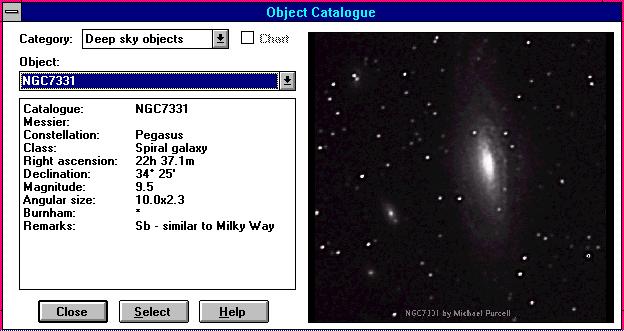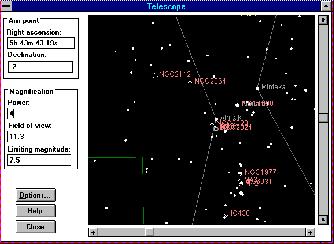Software Review - Home Planet
Jack Kramer
As mentioned in a prior edition of this newsletter, we now have the program Home Planet in the LCAS software library. The program is quite good, and this is especially amazing because it's public domain software. It's not even shareware that you feel guilty about using without paying the generally modest purchase price to the author.
Is it perfect? Well, no...but then nothing ever is. For one thing, it does so much that unless you have a pretty fast PC, you might as well go out for lunch while it creates or modifies a sky chart. It took forever on my 486SX, 25 mhz machine.
There are some ways you can customize the program. One way is shown below. The "Object Catalog" screen includes space for a picture of the object. However, as the program comes, there are very few pictures included. So in the example shown below, I converted one of Mike Purcell's CCD images to a bit mapped file and placed it in the Home Planet subdirectory named "images". Now it appears whenever NGC 7331 is called up. I did the same thing using multicolored deep sky images from a variety of other sources. For some unknown reason, though, one of these other images (a picture of the Pleiades) caused such a serious error in the program that it was necessary to reboot the PC in order to return to Windows.

The program uses the typical Windows graphical user interface, which is quite intuitive. But there's also a useful Help menu.

The screen shown at right is the "telescope" view that allows you to home in on a particular area of the sky. If you intend to use the sky atlas portion of the program, you will have to home in, because the all-sky view is so small that it becomes a confused muddle. Even this telescopic view is illegible in spots. There are so many deep sky objects in this part of Orion that the object designations are piled one atop the other. You have to go to a considerably magnified view before there's enough separation between objects to allow for the designations to be cleanly separated.
The program also allows you to track satellites. There is included a graphical representation of the Moon's phases, a day/night view of the Earth, numerous object databases, listing of meteor showers, and even a screen saver. Personally, I've found very few shareware programs that I've actually used beyond the initial tryout, much less so a public domain program. But this one's a keeper!
Published in the June 1997 issue of the NightTimes




